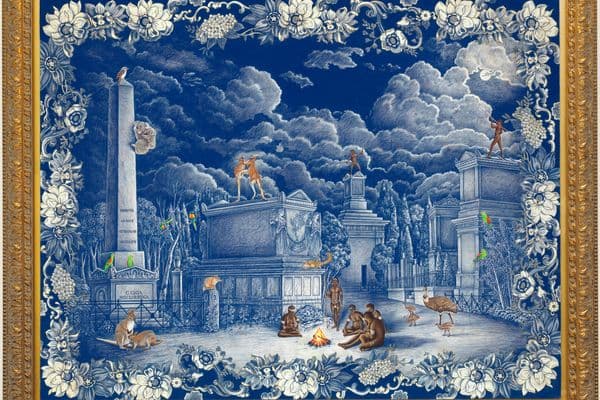Donald Judd

'Donald Judd', 1990
Judd Foundation Archives © Judd Foundation. Licensed by VAGA, New York, NY
Photographer: Todd Eberle
Donald Judd’s Minimalist work revolutionised modern sculpture. Judd studied painting at the Art Students League in New York while simultaneously taking a course in philosophy at Columbia University. In 1965 he published the article ‘Specific objects’, having turned to art writing and criticism after his first exhibition of paintings left him displeased. The article became a decisive text for the Minimalist movement and Judd its key artist.
Judd worked at Gemini GEL in 1971 to create an untitled sculpture edition. Made from stainless steel and acrylic sheeting, the work is a telling example of Minimalism’s rejection of the traditional notion of representational sculpture.
Emilie Owens
Works in the Kenneth E. Tyler Collection
Chronology
1928 Born in Excelsior Springs, Missouri, United States of America
1946-47 Serves in the U.S. Army in Korea
1948 Registers at the Art Student League, New York; transfers to College of William and Mary, Williamsburg, Virginia
1949 Studies Philosophy at Columbia University, New York; studies painting at the Art Student League, New York
1957 First solo exhibition, Don Judd, Panoramas Gallery, New York. Studies Art History at Columbia University, New York, under Rudolf Wittkower and Meyer Shapiro
1959 Begins writing for journal, Art News
1960 Works as contributing editor of journal, Arts Magazine; works as reviewer for journal, Art International
1961-63 Begins producing woodcuts, his first attempt at the print medium; produces a series of twenty six woodcuts, Untitled
1962 Begins producing relief prints as his painting develops into low reliefs, high reliefs and then to free standing sculpture; wall pieces and floor pieces are made of precise geometric forms without bases. Receives Masters of Fine Arts from Columbia University, New York
1962-4 Teaches at Brooklyn Institute of Arts and Sciences, New York
1963 Solo exhibition, Don Judd, Green Gallery, New York
1965 Publishes essay, Specific Objects in Arts Yearbook 8. Receives travel grant from the Swedish Institute
1966 First in a series of extended solo exhibitions at Leo Castelli Gallery, New York; visiting artist at Dartmouth College, Hanover, New Hampshire
1967 Teaches at Yale University, New Haven, Connecticut as instructor of sculpture; receives grant from National Endowment for the Arts
1968 Solo exhibition, Don Judd, at The Whitney Museum of American Art, New York; received grant from John Simon Guggenheim Memorial Foundation
1968-69 Produces his second group of woodcuts, Untitled
1970 Solo exhibition, Don Judd, at Stedlijk van Abbemuseum, Eindhoven, Holland
1971 Creates multiple Untitled, at Gemini GEL, Los Angeles; participates in the Guggenheim International Award exhibition at the Solomon R. Guggenheim Museum, New York
1972 Moves to Marfa, Texas
1974-79 Produces a series of eighteen aquatints, Untitled; included in exhibition, Dan Flavin/Donald Judd/ Sol LeWitt, at Galleria La Bertesca, Milan, Italy
1975 Publishes Completed Writings 1959-1975 (Halifax: Press of the Nova Scotia College of Art and Design), his first of two volumes of theoretical writing on Minimalism
1976 Baldwin Professor, at Oberlin College, Ohio; receives grant from the National Endowment for the Arts; solo exhibition, Skulpturen, at Kunsthalle, Bern, Switzerland
1980 Participated in the Venice biennale, Italy
1982 Participates in Documenta, Kassel, West Germany
1983 Begins lecturing at various universities across the Untied States, Europe and Asia on art and architecture
1983-85 Produces a series of twenty seven etchings, Untitled
1986 Produces a series of four woodcuts, Untitled. Included in exhibition, Qu’est-ce que la sculpture, Musée d’Art Moderne, Paris, France. Opens the Chinati Foundation/La Fundación Chinati, Marfa
1987 Solo exhibition, Donald Judd, Stedlijk van Abbemuseum, Eindhoven, travels to Düsseldorf, Paris, Barcelona and Turin
Publishes, Complete Writings, 1975–1986 (Eindhoven: Stedelijk van Abbemuseum), his second volume of theoretical writing on Minimalism. Receives the Skowhegan Medal for Sculpture by the Skowhegan School of Painting and Sculpture, Mayne, Canada; receives the Brandeis University Medal for Sculpture from Brandeis University, Waltham, Massachusetts
1988 Travelling exhibition, Donald Judd, organised by The Whitney Museum of American Art, New York, travels to Texas
Begins operation of El Taller Chihuahuense, factory for sculpture in Marfa
1990 Establishes studio in Cologne, Germany
1991 Founds publishing company, Der Zweite Pfeil, with Marianne Stockebrand
1992 Receives award from Stankowski Foundation, Stuttgart, Germany
1993 Solo exhibition, Donald Judd, prints 1951-1993, Haags Gemeentemuseum, The Hague, Holland; solo travelling exhibition, Kunst + design, originates at Museum Wiesbaden, Wiesbaden, Germany. Receives award from the Sikkens Foundation, Sassenheim, Holland
1994 Donald Judd died in New York
Compiled by Simeran Maxwell, 2007
This chronology provides an overview of selected biographical information, major solo and group exhibitions held within the artist's own lifetime. It builds upon the biographical information published in Donald Judd: prints and works in editions: a catalogue raisonné (New York, Edition Schellman, 1993); Donald Judd (London: Tate Publishing, 2004); and on the Guggenheim website.
Further Reading
NATIONAL GALLERY PUBLICATIONS
- Workshop: The Kenneth Tyler Collection, Jane Kinsman (ed.), 2015
RELATED LINKS











